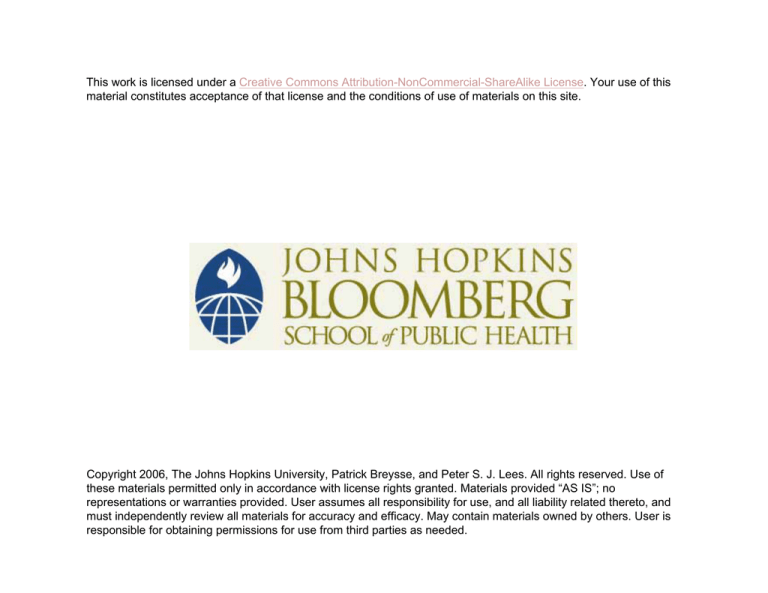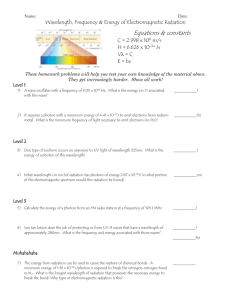
This work is licensed under a Creative Commons Attribution-NonCommercial-ShareAlike License. Your use of this
material constitutes acceptance of that license and the conditions of use of materials on this site.
Copyright 2006, The Johns Hopkins University, Patrick Breysse, and Peter S. J. Lees. All rights reserved. Use of
these materials permitted only in accordance with license rights granted. Materials provided “AS IS”; no
representations or warranties provided. User assumes all responsibility for use, and all liability related thereto, and
must independently review all materials for accuracy and efficacy. May contain materials owned by others. User is
responsible for obtaining permissions for use from third parties as needed.
Non-Ionizing
Electromagnetic Radiation
Patrick N. Breysse, PhD, CIH
Peter S.J. Lees, PhD, CIH
Johns Hopkins University
Section A
Introduction: Electromagnetic
Radiation
Electromagnetic Radiation
4
EM Radiation
Electromagnetic wave can be
characterized by the following:
– Electric and magnetic field strengths
– Wavelength
– Frequency
– Energy
Continued
5
EM Radiation
f =
c
λ
and
E = hf
f = frequency (Hz, sec-1)
λ = wavelength (cm)
c= speed of light (3x1010 cm/sec)
h= Planck’s constant (4.13x10-15 eVsec)
E=photon energy (eV)
6
Electromagnetic Spectrum
Non-Ionizing Radiation
Ionizing Radiation
7
EM Radiation
Ionizing radiation (expressed as photon
energy)
– X-rays (>100 eV)
– Gamma-rays (>100keV)
Continued
8
EM Radiation
Optical radiations (expressed as
wavelength)
– UV (0.4 –0.1um)
– Visible (0.7–0.4 um)
– Infrared (300–0.7 um)
Continued
9
EM Radiation
Radio frequency radiations (expressed
as frequency)
– Microwaves (300 MHz–300GHz)
– Radio frequency (300 Hz–300 MHz)
– Extremely Low Frequency (ELF)
(30 Hz–300 Hz)
10
Non-Ionizing vs. Ionizing
Ionizing
– EM energy with sufficient energy to
create ions (~12 eV)
– Can cause direct genetic damage
Continued
11
Non-Ionizing vs. Ionizing
Non-ionizing
– Less energy
– Cause changes in vibration and
rotational energies
– Dissipated as heat
12
Section B
Sources
http://www.osha-slc.gov/SLTC/radiofrequencyradiation/rfpresentation
Sources of RF/MW Exposure
Dielectric heaters
Induction heaters
Microwave heaters
– Including microwave ovens
Broadcast communications
– AM/FM
– VHF/UHF
Continued
14
Sources of RF/MW Exposure
Radar
Diathermy
Cell phones
Cathode ray tubes (VDTs)
Baby monitors
Wireless web
Magnetic resonance imagers (MRIs)
15
Section C
Measurement Concepts
EM Field Concepts
Power density (PD)
– Radiant power per unit area
(mW/cm2 or W/m2)
Electric fields (E)
– Units (V/m)
Magnetic field (H)
– Units (A/m)
Continued
17
EM Field Concepts
2
E
2
PD =
= 37 . 7 H
3770
PD = Power density (mW/cm2)
E = Electric field (V/m)
H = Magnetic field (A/m)
18
Example
What are the E and H field strengths for
a PD equal to 10 mW/cm2?
E =
H =
( 3770 )(10 mW / cm ) = 194 V / m
2
10 mW / cm
37 .7
2
= 0 .52 A / m
19
Inverse Square Law
Applies to energy radiation
Describes the change in energy as a
function of distance
I2
⎛ d
= I 1 ⎜⎜
⎝ d
1
2
⎞
⎟⎟
⎠
2
Continued
20
Inverse Square Law
I1 and I2 are the intensities and
distances 1 and 2 respectively
d1 and d2 are distances 1 and 2,
respectively
21
Inverse Square Law: Example
If the power density three feet from an
antenna is 100 mW/cm2, what is the
power density six feet away?
⎛ 3ft ⎞
I 2 = 100 mW / cm ⎜
⎟
⎝ 6ft ⎠
2
2
= 25 mW / cm
2
22
Near Field vs. Far Field
Near field
– Close to source relative to its size
and wavelength
– Need to measure E field and H field
separately
– Inverse square law does not apply
– Significant spatial variability
– Can be subdivided into radiating and
non-radiating near field regions
Continued
23
Near Field vs. Far Field
Far field
– Distance far from the antenna
relative to its size and wavelength
– Assume antenna is a point source
– Inverse square law applies
– E, H, or PD can be measured
because they are interchangeable
24
Section D
Standards and Guidelines
Health Concerns
RF/MW energy can penetrate deeper
into tissues than optical radiations
Energy deposition creates thermal
(heating) stresses
– Heat stress
– Depressed spermatogenesis
– Occular damage
Continued
26
Health Concerns
Thermal effects well documented
Heat is perceived only at high
exposures
Continued
27
Health Concerns
Athermal effects
– Occur at exposure levels below
which thermal effects exist
– Not well documented
• Behavioral
• CNS effects
• Reproductive effects
• Cancer
– Subject of more research
28
Current OSHA Standard
Currently - 10 mW/cm2
Based on 1966 American National
Standards Institute (ANSI) Guideline
Protects against excess thermal load
Exposures are averaged over a sixminute period
29
Current Exposure Guidelines
American Conference of Governmental
Industrial Hygienists (ACGIH) has a
Threshold Limit Value (TLV)
Institute for Electrical and Electronics
Engineers (IEEE) publishes a Maximum
Permissible Exposure (MPE) Limit
Both are based on limiting Specific
Absorption Rate (SAR) below 0.4 W/kg
30
Specific Absorption Rate (SAR)
The specific absorption rate is defined
as the rate of energy deposition per unit
mass, W/kg
Defines absorbed energy dose
Analogous to a biomarker of chemical
exposure
Continued
31
Specific Absorption Rate (SAR)
SARs less than 0.4 W/kg are
considered protective for thermal
effects
– This level incorporates a ten-fold
safety factor
32
106
Surface
heating
range
Sub-resonant
104
range
102
101
Whole-body
resonant range
102
10-2
103
10-1
100
101
102
103
Power Density, W/m2
Electric Field Strength, V/m
Generic Human Exposure
Guideline
104
Frequency, MHz
33
Current Exposure Guidelines
Absorption envelope
– SAR is frequency dependent
– Three exposure regions
1. Sub-resonant range
2. Whole-body resonant range
3. Surface heating range
– Body absorbs RF/MW differently at
different frequencies
34
Averaging Time
Six-minute averaging time generally
used for exposure limits
Based on cooling time constants
derived from animal experiments
Longer exposures can be compensated
for by the body’s thermoregulatory
mechanisms
35
IEEE C95.1-1991
36





